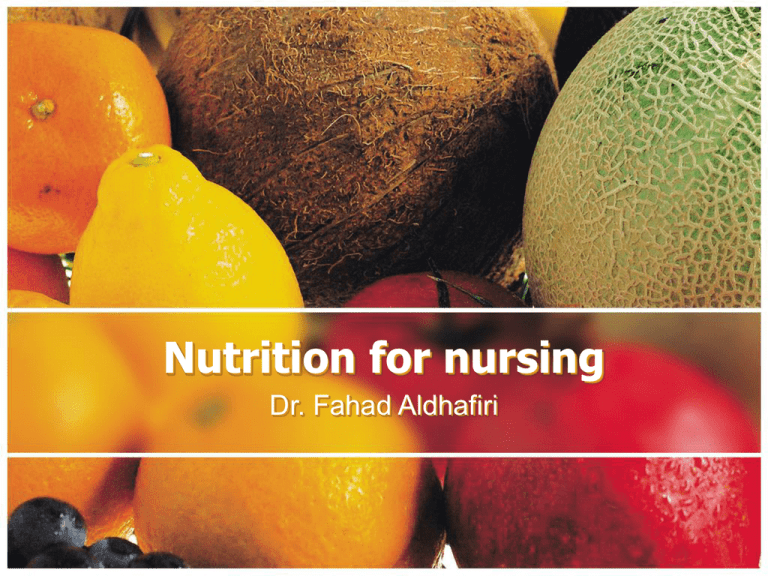المحاضرة 7 الجزء الاول
advertisement

Nutrition for nursing Dr. Fahad Aldhafiri Nutrition throughout the life cycle INFANCY (BIRTH TO 1 YEAR) • Birth weight doubles by 4 to 6 months of age and triples by the first birth-day. • Length (height) increases by approximately 10 in during the first year. Breast Milk • Breast milk is specifically designed to support optimal growth and development in the newborn, and its composition makes it uniquely superior for infant feeding. • Breastfeeding is credited with numerous potential health benefits for the infant, including lower risks of otitis media, upper respiratory tract infection, lower respiratory tract infection, asthma, atopic dermatitis, gastroenteritis, obesity, celiac disease, type 1 and type 2 diabetes, certain types of leukemia, and sudden infant death syndrome. Infant Formula • Infant formulas may be used in place of breastfeeding, as an occasional supplement to breastfeeding, or when exclusively breastfed infants are weaned before 12 months of age. • Term formulas contain cow’s milk protein and lactose and are made to resemble human milk. • Recently, formulas with long-chain polyunsaturated fatty acids (arachidonic acid and docosahexaenoic acid [DHA], an omega-3 fatty acid) have been marketed to promote eye and brain development (O’Connor, 2009). They are more costly than routine formulas, and most well-conducted randomized trials show no benefit t to using them. Infant Feeding and Obesity • Many overweight infants remain overweight as children; childhood obesity has long been known as a strong predictor of adult obesity. • Breastfeeding duration and/or exclusivity has been inversely related to the rate of weight gain during infancy and with weight and risk of overweight and obesity in toddlers and preschoolers. Complementary Foods Introducing Solids • Developmentally, most infants exhibit readiness to spoonfeed around 4 to 6 months of age. • For both breastfed and formula-fed infants, iron-fortified infant cereal is traditionally the first solid food introduced. • Iron-fortified infant cereals are recommended until the infant is 12 to 18 months old because the iron in these cereals is absorbed more readily than that from other cereals. • New foods should be introduced in plain and simple form one at a time for a period of 5 to 7 days to identify allergic reactions, such as rashes, fussiness, vomiting, diarrhea, or constipation. If there is a positive family history for food allergies, milk, eggs, wheat, and citrus fruits should be introduced cautiously. • Peanuts and peanut butter should be avoided because of the potential for severe allergic reaction. NUTRITION FOR TODDLERS AND PRESCHOOLERS • Evidence suggests that dietary habits acquired in early childhood persist through to adult-hood (Kelder, Perry, Klepp, and Lytle, 1994). • Parents are the primary gatekeepers and role models for their young children’s food intake and habits; their feeding practices and style have been shown to affect children’s eating behavior and their weight status (de Lauzon-Guillain et al., 2012). Calories and Nutrients NUTRITION FOR CHILDREN • School-age children • As children get older, they consume more foods from non home sources and have more out-side influences on their food choices. School, friends’ houses, childcare centers, and social events present opportunities for children to make their own choices beyond parental supervision. • Family meals promote social interaction and allow children to learn food-related behaviors. Parents should provide and consume healthy meals and snacks and avoid or limit emptycalorie foods. NUTRITION FOR ADOLESCENTS (12–18 YEARS) • The slow growth of childhood abruptly and dramatically increases with pubescence until the rate is as rapid as that of early infancy. Adolescence is a period of physical, emotional, social, and sexual maturation. • Approximately 15% to 20% of adult height and 50% of adult weight are gained during adolescence. Fat distribution shifts and sexual maturation occurs. • Gender differences are obvious. For instance, girls generally experience increases in growth between 10 and 11 years of age and peak at 12 years. Because peak weight occurs before peak height, many girls and parents become concerned about what appears to be excess weight. • In contrast, boys usually begin the growth spurt at about 12 years of age and peak at 14 years. Stature growth ceases at a median age of approximately 21 years. • Nutritional needs increase later for boys than for girls. • In early adolescence, peer pressure overtakes parental influence on food choices. As the adolescent becomes increasingly independent, more self-selected meals and snacks are purchased and eaten outside the home. • A natural increase in appetite combined with fastfood marketing practices geared toward adolescents and a decrease in physical activity increase the risk of overeating. NUTRITION CONCERNS DURING CHILDHOOD AND ADOLESCENCE • Overweight and Obesity • Breakfast Skipping

